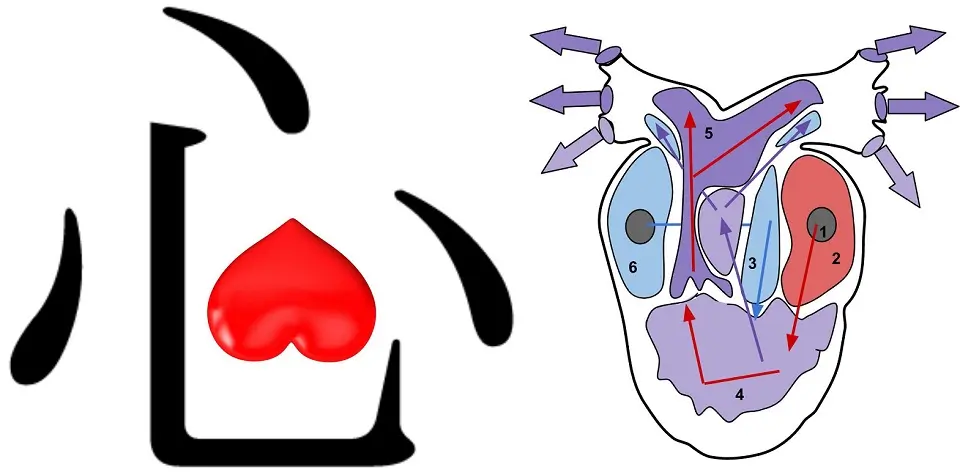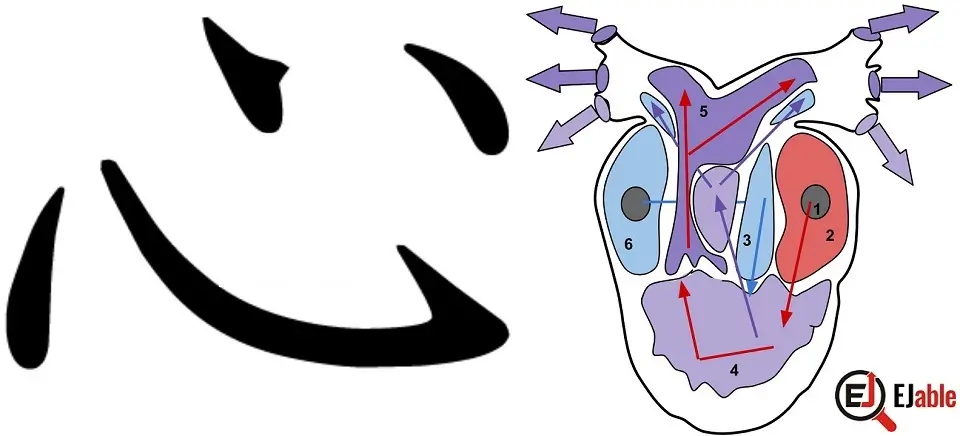Kanji for Heart: 心 (Kokoro)

The Japanese kanji for “Heart” is 心. The Kunyomi or the Japanese pronunciation of the Kanji 心 is Kokoro (こころ), and the Onyomi (Chinese) pronunciation is “shin” (シン).
Heart’s Kanji is constructed with 4 strokes. This Kanji is a part of the JLPT N4 syllabus (please check the list of JLPT N4 kanji). In Japanese schools, this Kanji is taught in grade 2.
This article will discuss the origin of Heart’s Kanji and easy ways to remember it. We will also discuss the radicals of this Kanji and the compounded words in which it appears.
Other meanings of 心
While the kanji 心 primarily represents the physical “heart,” it also has broader connotations in Japanese. Here are some other meanings and nuances associated with 心:
- Mind: 心 can refer to a person’s mind or mental and emotional faculties.
- Spirit: 心 can denote one’s spirit or inner essence.
- Feeling or Emotion: In various contexts, 心 might refer to a person’s feelings or emotions.
- Center or Core: In certain compound words, 心 can signify the core or center of something.
Construction and Origin of the Shape 心

The modern shape of the heart’s Kanji 心 is constructed with 4 strokes. However, like most other Kanji characters, the shape of this Kanji has evolved drastically over time.
The kanji for “heart,” 心, has its roots in ancient Chinese pictographs. The earliest forms of this character, found in oracle bone inscriptions and bronze inscriptions, showcased a more detailed representation of the human heart.
With its chambers and connecting vessels, it was a symbolic embodiment of life’s essence. Over the millennia, this pictograph underwent simplification, leading to the streamlined character we recognize today.
The early shapes showed chambers of the heart in place of the three small strokes of the modern Kanji. Later, an artery was added to that shape, which is the long stroke at the bottom of the modern Kanji.
Mnemonic: How to Remember the Kanji of Heart (心)
If we try to remember this Kanji as per the explanation of the origin, it may create confusion because it seems that there were three chambers (now three small strokes). However, humans and other mammals have four chambers, fishes have two chambers, and only reptiles have three chambers in their hearts.
So, the best way to remember this Kanji is to put it alongside the Kanji of the heart and imagine that the smaller strokes are for arteries, and the big stroke at the bottom represents the shape of the heart.
The following illustration will serve the purpose of a mnemonic to memorize this Kanji of heart:

Cultural Significance of Heart in Japanese
In Japanese culture, the heart 心 (“kokoro”) is considered the seat of emotion and the source of feelings. This focus on the heart aligns with many cultural, philosophical, and artistic traditions in Japan that prioritize emotion, empathy, and the human experience.
The depth of 心 can be seen in various idiomatic expressions in Japanese. For instance, “心が痛む” (kokoro ga itamu) translates to “heart aches,” but it’s used to express empathy or sorrow for someone else’s suffering. Another expression, “心から” (kokoro kara), which means “from the heart,” signifies a genuine, deep-felt emotion or action.
心 as a Radical and Component in other Kanji Characters
The Kanji for Heart also serves as a Kanji radical 心, along with its two variations 忄 (when it appears on the left side of a Kanji) and ⺗, commonly referred to as the “Heart radical.
When 心 is used as a radical, it often suggests meanings related to emotions, feelings, or thoughts. In its radical form, it can appear in a couple of variations, primarily depending on its position in the kanji. Heart’s Kanji appears as a radical or as a component in 364 Kanji characters, including 67 Jōyō Kanji.
Examples of 心 as a Radical
Following are some kanji examples that use the “heart” radical:
- 情 (jou): Emotion, feeling.
- 快 (kai): Pleasant, fast.
- 思 (shi): Think.
- 恐 (kyou): Fear.
- 悪 (aku): Bad, evil.
- 愛 (ai): Love.
- 忘 (bou): Forget.
- 懐 (kai): Pocket; to yearn.
- 忍 (nin): Endure.
- 急 (kyuu): Hurry.
- 悲 (hi): Sad.
- 憂 (yuu): Melancholy.
- 怒 (do): Anger.
- 忙 (bou): Busy.
- 悩 (nou): Worry.
Each of the above Kanji characters carries a sense of emotion or mental state, and the “heart” radical is key to their meanings. In its various forms, the heart radical acts as a semantic indicator, providing a hint about the emotional or cognitive aspect of the kanji in which it appears.
Heart (Kokoro/Shin)) Kanji in Compounded Words
The Kanji for the Heart frequently appears in compounded Japanese words’ kanjis. There are 374 Japanese words that begin with the Kanji 心, and it appears in 898 words.
Examples of Kanji 心 in Compounded Kanji Characters
Following are the examples where Kanji for heart (心) appears in Japanese compounded Kanji characters:
- 心配 (しんぱい, shinpai): Worry, concern.
- 気心 (きごころ, kigokoro): Disposition, temperament.
- 心地 (ここち, kokochi): Feeling, sensation.
- 心情 (しんじょう, shinjou): Emotions, feelings.
- 心得る (こころえる, kokoroeru): To know well, to understand.
- 心強い (こころづよい, kokorozuyoi): Heartening, reassuring.
- 心細い (こころぼそい, kokorobosoi): Lonely, helpless.
- 心理 (しんり, shinri): Psychology, mentality.
- 心臓 (しんぞう, shinzou): Heart (organ).
- 真心 (まごころ, magokoro): Sincerity, devotion.
- 心中 (しんじゅう, shinjuu): Double suicide; feelings.
- 一心 (いっしん, isshin): Wholehearted, one’s whole heart.
- 心外 (しんがい, shingai): Unexpected, regrettable.
- 心当たり (こころあたり, kokoroatari): Idea, hint, clue.
- 心音 (しんおん, shin’on): Heart sounds.
Each of the above compounded Kanjis contains the kanji for heart, i.e., 心, and conveys meanings that revolve around emotions, feelings, thoughts, or states of mind.
Check other Kanji characters on the page “How to Remember Kanji“.

A long-term ex-pat in Japan, Himanshu comes with an IT background in SAP consulting, IT Business Development, and then running the country operations of an IT consulting multinational. Himanshu is the co-founder and Managing Director of ReachExt K.K. and EJable.com. He is also an Advisory Board Member of a Silicon Valley AI/IoT startup.
